Terry L. Ettinger Horticulture Consulting Services
Meeting The Needs Of Today With A Vision For The Future
Special Topics
Leaves Aren't Trash
Mow'em, Don't Rake'em
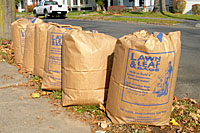 Many municipalities encourage residents to rake leaves to the curb for collection each autumn. This process involves
specialized vacuum equipment and/or payloaders and convoys of dump trucks to collect, haul and process hundreds to thousands
of loads of leaves at a cost that’s been estimated at well over one hundred dollars per truckload!
Many municipalities encourage residents to rake leaves to the curb for collection each autumn. This process involves
specialized vacuum equipment and/or payloaders and convoys of dump trucks to collect, haul and process hundreds to thousands
of loads of leaves at a cost that’s been estimated at well over one hundred dollars per truckload!
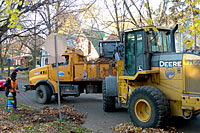 In
the City of Syracuse, for example, it's been reported that sixty
Department of Public Works employees work ten hours a day throughout
the month of November collecting and hauling almost 3,000 truckloads
of leaves!
In
the City of Syracuse, for example, it's been reported that sixty
Department of Public Works employees work ten hours a day throughout
the month of November collecting and hauling almost 3,000 truckloads
of leaves!
In my opinion, this is an almost complete waste of time, equipment and fuel! And, research conducted at Cornell, Purdue, Rutgers, Michigan State and other universities since the early 1990’s supports this opinion.
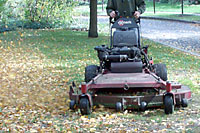 For
example, between 1995 and 1998 researchers at Michigan State set mower decks to cut at three
inches, then mowed up to 450 pounds of leaves per 1,000 square feet of lawn each autumn (that’s equivalent to about eighteen
inches of leaves).
For
example, between 1995 and 1998 researchers at Michigan State set mower decks to cut at three
inches, then mowed up to 450 pounds of leaves per 1,000 square feet of lawn each autumn (that’s equivalent to about eighteen
inches of leaves).
At such a high rate, very little grass could be seen at the end of the mowing season. However, once growth resumed the following spring the remaining leaf litter quickly decomposed. In this study not only was the excessive volume of leaves not harmful, the shredded leaves actually improved lawn quality over time as organic matter and nutrients in the decomposing leaves was returned to the soil.
Amazing!
These research projects show that you can save time and improve your lawn—by never raking again. As an added bonus, your community’s public works crews might be able to devote more attention to more important matters, like fixing potholes? Plus, wouldn’t it be great to not wake up in the middle of the night several times in October as leaf collection crews make their way down your street in the wee hours of the morning?
Keeping your leaves out of the street can help our streams, rivers and lakes, too!
How’s that?
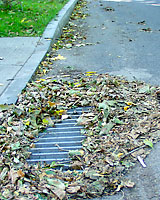 Well, if you’ve raked leaves to the curb for collection in the past, you know that it’s often at least several days
before collection crews make it to your street. Before they arrive, it’s not at all unusual for it to rain several times,
washing many of your leaves down the street and into a catch basin. Once in the catch basin the next stop for your leaves
and those of all of your neighbors is the stream, creek or river that flows through your city, town or village.
Well, if you’ve raked leaves to the curb for collection in the past, you know that it’s often at least several days
before collection crews make it to your street. Before they arrive, it’s not at all unusual for it to rain several times,
washing many of your leaves down the street and into a catch basin. Once in the catch basin the next stop for your leaves
and those of all of your neighbors is the stream, creek or river that flows through your city, town or village.
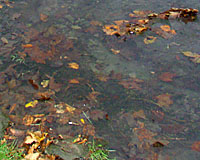 As these leaves decompose they release nitrogen, phosphorus, potassium and more than a dozen other elements that
accumulate in each leaf during the growing season. While these elements are “natural,” they’re every bit as harmful to our
surface waters as the identical nutrients pouring out of a sewage treatment plant!
As these leaves decompose they release nitrogen, phosphorus, potassium and more than a dozen other elements that
accumulate in each leaf during the growing season. While these elements are “natural,” they’re every bit as harmful to our
surface waters as the identical nutrients pouring out of a sewage treatment plant!